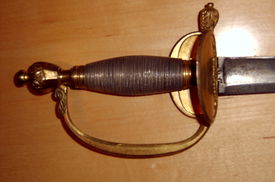28:
254:
197:
80:
75:
which had been common civilian wear until shortly before this period. The pommel was urn shaped and, in many later examples, the inner guard was hinged to allow the sword to sit against the body more comfortably and reduce wear to the officer's uniform. Blades were commonly quite extensively
51:
70:
blade, i.e. one straight, flat backed and single edged with a single fuller on each side. The hilt was of gilt brass or gunmetal, with a knucklebow, vestigial quillon and a twin-shell guard somewhat similar in appearance to that of the
92:
The 1796 Pattern Sword was not renowned as a great fighting sword. The blade was weak and the hilt gave very little protection to the hand. General
Cavalie Mercer of the Royal Artillery, who wore the same sword stated that:
96:"Nothing could be more useless or ridiculous than the old infantry regulation ; it was good for neither cut nor thrust and was a perfect encumberance. In the Foot Artillery, when away from headquarters, we generally wore
339:
144:
Withers, Harvey J.S: British
Military Swords 1786-12912 The Regulation Patterns, The Regulation Patterns 1788 to 1914, First Edition 2003, Studio Jupitor Military Publishing
112:
in the early nineteenth century and in turn similar swords were adopted by the United States Army in 1840 for foot officers and (with a simpler, unhinged guard) for NCOs.
295:
319:
109:
66:
The sword was introduced by
General Order in 1796, replacing the previous Pattern 1786 sword. It was similar to its predecessor in having a
238:
288:
165:
149:
126:
121:
334:
314:
349:
160:
Robson, Brian: Swords of the
British Army, The Regulation Patterns 1788 to 1914, Revised Edition 1996, National Army Museum
281:
32:
108:
Regardless of its weaknesses as a fighting weapon, according to Robson, a nearly identical sword was carried by the
17:
329:
324:
231:
344:
27:
224:
161:
145:
265:
208:
253:
261:
55:
308:
43:
180:
Detailed images of 1796 British
Infantry Officer's Sword with appropriate Sword Knot
47:
179:
72:
67:
196:
182:
79:
204:
78:
26:
97:
50:
between 1796 and the time of its official replacement with the
269:
212:
340:
19th-century military history of the United
Kingdom
54:in 1822. This period encompassed the whole of the
18:1796 Pattern British Infantry Officer's Sword
289:
232:
40:Pattern 1796 British infantry officer's sword
8:
296:
282:
239:
225:
137:
104:Influence on United States Army swords
260:This article about the period of the
7:
250:
248:
193:
191:
268:. You can help Knowledge (XXG) by
211:. You can help Knowledge (XXG) by
25:
76:decorated, often blued and gilt.
252:
195:
127:Pattern 1796 heavy cavalry sword
122:Pattern 1796 light cavalry sabre
42:was carried by officers of the
1:
320:Early Modern European swords
33:Auckland War Memorial Museum
366:
247:
190:
203:This article relating to
83:Hilt of the 1796 Pattern
110:Army Corps of Engineers
31:Sword with scabbard in
335:Modern European swords
315:British service swords
84:
35:
350:Napoleonic Wars stubs
82:
30:
52:gothic hilted sword
85:
36:
277:
276:
264:(1803–1815) is a
220:
219:
16:(Redirected from
357:
330:European weapons
298:
291:
284:
256:
249:
241:
234:
227:
199:
192:
168:
158:
152:
142:
100:instead of it".
21:
365:
364:
360:
359:
358:
356:
355:
354:
325:European swords
305:
304:
303:
302:
262:Napoleonic Wars
246:
245:
188:
176:
171:
159:
155:
143:
139:
135:
118:
106:
90:
64:
56:Napoleonic Wars
23:
22:
15:
12:
11:
5:
363:
361:
353:
352:
347:
342:
337:
332:
327:
322:
317:
307:
306:
301:
300:
293:
286:
278:
275:
274:
257:
244:
243:
236:
229:
221:
218:
217:
200:
186:
185:
175:
174:External links
172:
170:
169:
153:
136:
134:
131:
130:
129:
124:
117:
114:
105:
102:
89:
86:
63:
60:
24:
14:
13:
10:
9:
6:
4:
3:
2:
362:
351:
348:
346:
343:
341:
338:
336:
333:
331:
328:
326:
323:
321:
318:
316:
313:
312:
310:
299:
294:
292:
287:
285:
280:
279:
273:
271:
267:
263:
258:
255:
251:
242:
237:
235:
230:
228:
223:
222:
216:
214:
210:
206:
201:
198:
194:
189:
184:
181:
178:
177:
173:
167:
166:0-901721-33-6
163:
157:
154:
151:
150:0-9545910-0-3
147:
141:
138:
132:
128:
125:
123:
120:
119:
115:
113:
111:
103:
101:
99:
94:
87:
81:
77:
74:
69:
61:
59:
57:
53:
49:
45:
44:line infantry
41:
34:
29:
19:
270:expanding it
259:
213:expanding it
202:
187:
156:
140:
107:
95:
91:
65:
48:British Army
39:
37:
345:Sword stubs
73:smallswords
309:Categories
133:References
88:Criticism
116:See also
68:spadroon
183:replica
46:in the
205:swords
164:
148:
62:Design
207:is a
98:dirks
266:stub
209:stub
162:ISBN
146:ISBN
38:The
311::
58:.
297:e
290:t
283:v
272:.
240:e
233:t
226:v
215:.
20:)
Text is available under the Creative Commons Attribution-ShareAlike License. Additional terms may apply.

